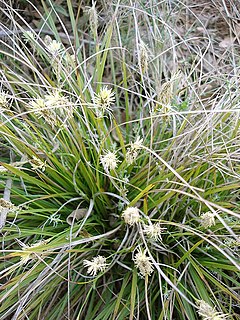
Carex is a vast genus of more than 2,000 species of grass-like plants in the family Cyperaceae, commonly known as sedges. Other members of the family Cyperaceae are also called sedges, however those of genus Carex may be called true sedges, and it is the most species-rich genus in the family. The study of Carex is known as caricology.
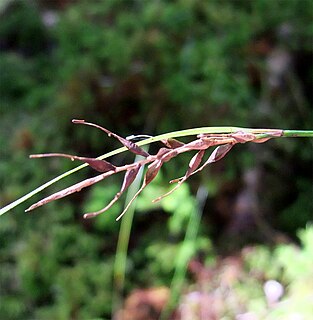
Uncinia is a genus of flowering plants in the family Cyperaceae, known as hook-sedges in Australia and as hook grasses or bastard grasses in New Zealand. The genus is characterised by the presence of a long hook formed by an extension of the rachilla, which is used to attach the fruit to passing animals (epizoochory), especially birds, and it is this feature which gives the genus its name, from the Latin uncinus, meaning a hook or barb.

In botany, a perigynium, also referred to as a utricle, typically refers to a sac that surrounds the achene of plants in the genus Carex (Cyperaceae). The perigynium is a modified prophyll, tissue of leaf origin, that encloses the dry, one-seeded achene.
Carex klamathensis is a rare species of sedge known by the common name Klamath sedge. It is known from 15 or fewer populations in southern Oregon and three populations in the Klamath Region of northern California. It was described to science only in 2007. Its habitat includes fens and other wet habitat, on serpentine soils.
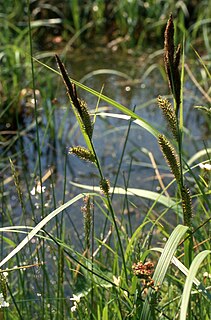
Carex riparia, the greater pond sedge, is a species of sedge found across Europe and Asia. It grows in a variety of wet habitats, and can be a dominant species in some swamps. It is Britain's largest Carex, growing up to 130 cm tall, with glaucous leaves up to 160 cm long. It hybridises with a number of other Carex species, including the closely related Carex acutiformis – the lesser pond sedge. A variegated cultivar is grown as an ornamental grass.

Carex hirta, the hairy sedge or hammer sedge, is a species of sedge native across Europe. It has characteristic hairy leaves and inflorescences, and is the type species of the genus Carex.

Carex binervis, the green-ribbed sedge, is a European species of sedge with an Atlantic distribution. It is found from Fennoscandia to the Iberian Peninsula, and occurs in heaths, moorland and other damp, acidic environments. It typically grows to a height of 15–120 cm (6–50 in), and has inflorescences comprising one male and several female spikes, each up to 45 mm (1.8 in) long. The utricles have two conspicuous green veins, which give rise to both the scientific name and the common name of the species. In the vegetative state, it closely resembles C. bigelowii, a species that usually grows at higher altitude. C. binervis was first described by James Edward Smith in 1800, and is classified in Carex sect. Spirostachyae; several hybrids with other Carex species are known.
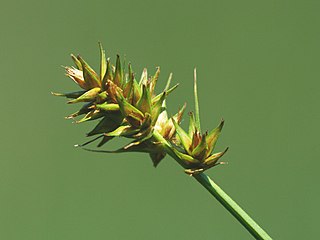
Carex otrubae, the false fox-sedge, is a species of flowering plant in the sedge family, Cyperaceae.

Carex distans, commonly known as distant sedge, is a plant species in the sedge family, Cyperaceae. It is native to Europe and North Africa. It is part of a complex of similar species that occur across Eurasia. Its relatives include Carex diluta of central Asia, which has also introduced to North America in Montana. Carex distans has been introduced to the US states including Maryland and Pennsylvania. More recently, it was found in Oregon. There is a report from Victoria, Australia as well.
Carex longebrachiata, commonly known as Australian sedge or drooping sedge, is a plant species in the sedge family, Cyperaceae. It is native to Australia.
Carex aboriginum is a species of sedge endemic to Idaho in the western United States, known as Indian Valley sedge. It was not observed in the wild between 1910, when it was first described, and 1999. Until its rediscovery, C. aboriginum was considered the only plant native to Idaho to have become extinct, and it remains one of the state's rarest and most endangered plant species.
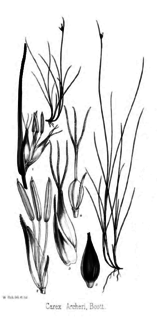
Carex archeri, known as Archer's sedge, is a species of sedge in the genus Carex, endemic to south-eastern Australia.
Carex micropoda is a species of sedge found in temperate and boreal regions of the Northern Hemisphere.
Carex hirtifolia, the pubescent sedge, is a species of sedge native to northeastern North America. It is the only species in Carex section Hirtifoliae. The entire plant is distinctively covered soft hairs.

Carex pulicaris, the flea sedge, is a species of sedge in the genus Carex native to Europe.

Ranunculus acaulis, in Australia and New Zealand called dune buttercup, sand buttercup or shore buttercup, is a yellow-flowered, small, fleshy herb, that grows in mats in damp places mostly near the sea. It occurs naturally in Australia, New Zealand, Chile and the Falklands. It flowers between August and April and sets seed from September till July.

Carex kobomugi is a species of sedge, known as the Japanese sedge or Asiatic sand sedge, that lives in sandy coastal areas of eastern Asia, and has become an invasive species in the north-eastern United States.

Carex appressa, commonly known as the tall sedge, is a species of flowering plant in the family Cyperaceae, commonly known as sedges.
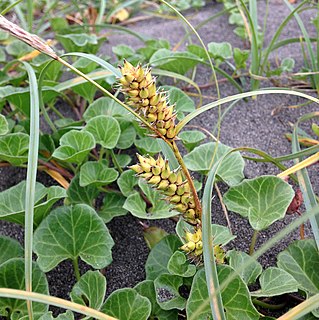
Carex pumila, commonly known as strand sedge or spreading sedge, is a species of sedge of the family Cyperaceae.
Carex arctogena is a member of the sedge family (Cyperaceae) which grows in high alpine areas. It is one of the few "bipolar" species; it has populations in Greenland, Scandinavia, Russia, Canada and southern South America. Plants in the far north and south appear to be genetically identical, having taken advantage of a similar niches on opposite ends of the globe.













